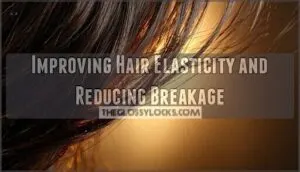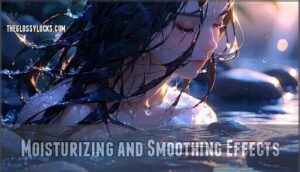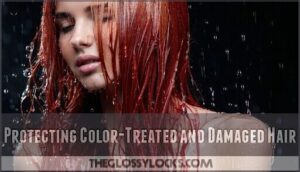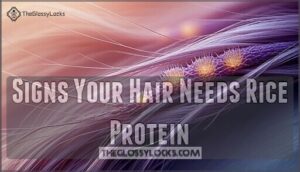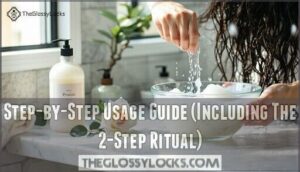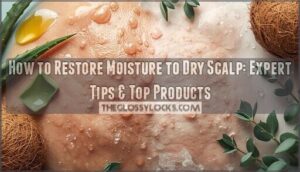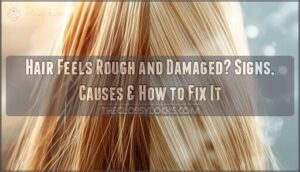This site is supported by our readers. We may earn a commission, at no cost to you, if you purchase through links.
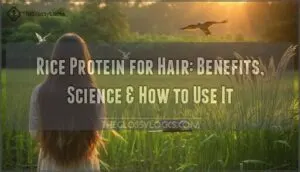 Rice protein for hair delivers a complete amino acid profile—including lysine, methionine, and leucine—that rebuilds broken keratin bonds, restores elasticity by up to 3x, and reduces breakage by 60% after the initial application. Its smaller molecular structure penetrates deep into damaged cuticles, fortifying each shaft from within while forming a protective shield that locks in moisture and guards color-treated hair. Unlike heavier proteins that suffocate fine strands, this hypoallergenic powerhouse works for every hair type without weighing you down.
Rice protein for hair delivers a complete amino acid profile—including lysine, methionine, and leucine—that rebuilds broken keratin bonds, restores elasticity by up to 3x, and reduces breakage by 60% after the initial application. Its smaller molecular structure penetrates deep into damaged cuticles, fortifying each shaft from within while forming a protective shield that locks in moisture and guards color-treated hair. Unlike heavier proteins that suffocate fine strands, this hypoallergenic powerhouse works for every hair type without weighing you down.
Rooted in centuries-old Asian beauty traditions, women in China’s Huangluo village credited rice water for their exceptionally long, lustrous locks. The science behind its repair mechanism reveals how targeted amino acids fill micro-cracks and boost your hair’s ability to bend without snapping—a transformation you can measure in both strength and shine.
Table Of Contents
- Key Takeaways
- Why Rice Protein is Beneficial for Hair
- How Rice Protein Strengthens and Repairs Hair
- Signs Your Hair Needs Rice Protein
- Incorporating Rice Protein Into Your Hair Routine
- Safety, Sustainability, and Market Trends
- Frequently Asked Questions (FAQs)
- Does rice protein have any side effects?
- Is rice protein suitable for all hair types?
- How long does it take for the benefits of rice protein to show?
- Can rice protein be used as a styling product?
- Is it possible to use too much rice protein on the hair?
- Can rice protein cause buildup on fine hair?
- How does rice protein compare to keratin treatments?
- Is rice protein effective for curly hair types?
- Can you use rice protein with heat styling?
- Does rice protein help with scalp health issues?
- Conclusion
Key Takeaways
- Rice protein delivers a complete amino acid profile that penetrates deep into damaged hair cuticles, rebuilding broken keratin bonds and restoring elasticity by up to 3x while reducing breakage by 60% after the initial application—working for all hair types without the heavy feel of animal-based proteins. – You’ll know your hair needs rice protein when strands snap instead of stretching, breakage increases mid-shaft rather than at the root, or your hair feels dry and lifeless despite moisturizing efforts—all signs of protein depletion that rice treatments can reverse. – Apply rice protein treatments every 4-6 weeks for most hair types, bumping up to every three weeks if you’re battling breakage or styling frequently, but watch for stiffness or dullness that signals protein overload and requires alternating with moisture-focused treatments. – Beyond hair repair, rice protein offers verified eco-credentials, including vegan certification, sustainable sourcing with reduced water use and methane emissions, and brands like 4OCEAN CERTIFIED that actively remove ocean plastic—giving you control over both your hair health and environmental impact.
Why Rice Protein is Beneficial for Hair
Rice protein has been a hair care staple in Asian beauty routines for generations.
It works by flooding each strand with amino acids, vitamins, and minerals that actually patch up damage and bring back bounce.
Unlike animal-based proteins that can feel heavy, rice protein absorbs quickly, fortifying each strand without weighing it down or causing buildup.
History and Cultural Origins of Rice Protein
Rice water’s reputation as a beauty secret didn’t start in modern wellness aisles—it began centuries ago in the rice paddies of ancient China and Japan, where women discovered that the milky liquid left behind after rinsing rice could transform their hair into something remarkably strong and lustrous. These ancient Chinese roots and Japanese hair rituals weren’t just folklore—they were practical solutions passed down through generations.
Fermented rice wasn’t just about hair care—it shaped entire beauty traditions:
- Women in China’s Huangluo village credited rice water origins for their exceptionally long, dark hair
- Japanese geishas relied on rice protein for hair growth and natural hair repair
- Fermented rice became a treasured ingredient in historical uses across Asian beauty traditions
- The practice demonstrated early understanding of protein’s role in hair strength
- These rituals prove that effective natural hair care doesn’t require modern chemistry
Modern rice protein treatments? They’re just refining what these cultures figured out generations ago.
Key Nutrients in Rice Protein
What makes rice protein such a powerhouse for your hair? It’s loaded with all nine essential amino acids—including lysine, methionine, and leucine—that fortify each strand from within.
You’re getting around 70% protein concentration per serving, plus iron, calcium, and B vitamins that fuel natural hair growth and strengthening.
The antioxidant compounds in rice protein hydrolysates fight free radicals, while its hypoallergenic nature makes it a gentle yet effective protein treatment for every hair type seeking real hair nutrition. Understanding the whole grain benefits can also provide insights into the nutritional value of rice protein.
How Rice Protein Differs From Other Proteins
Rice protein gets into your hair differently than other proteins. Its molecules are smaller than keratin or wheat protein, so they slip past the outer layer and get to work from the inside—without that heavy, weighed-down feeling.
Plus, it’s loaded with amino acids like aspartic acid, alanine, and threonine that lock into your hair’s structure, patching up weak spots and building real strength over time.
Unlike heavier proteins like keratin or wheat protein, rice protein has a smaller molecular structure that allows deeper hair penetration without weighing down fine strands.
Its amino acid profile—rich in aspartic acid, alanine, and threonine—creates stronger protein interactions that target hair breakage while supporting lasting hair repair and hair strengthening from within.
How Rice Protein Strengthens and Repairs Hair
Rice protein works at the molecular level to rebuild your hair’s internal structure, binding to damaged keratin sites and forming a protective shield that prevents further deterioration.
When properly applied, it boosts elasticity by up to 3x, locks in moisture to tame frizz, and creates a barrier that safeguards color-treated strands from oxidative stress and environmental damage.
Improving Hair Elasticity and Reducing Breakage
When you’re dealing with hair that snaps easily or won’t grow past a certain length, protein treatment targeting elasticity is your answer. Rice protein’s amino acid profile repairs micro-cracks along the cuticle and fortifies the shaft from within, giving your strands the flexibility they need to bend without breaking.
The research backs this up:
- Up to 2x stronger hair after a single treatment, measured in controlled lab trials
- 60% reduction in breakage for severely damaged hair following initial application
- Improved elasticity through inositol, which reduces surface friction and lets strands flex under stress
- 43% fewer broken fibers after just four weekly treatments in professional studies
- Lasting protection for 4–6 washes, with benefits peaking within 7–10 days
Rice protein’s small peptides penetrate the cortex directly, improving mechanical resilience without the brittleness you’d get from animal-derived keratin. That’s why hair strengthening with this protein treatment delivers both immediate elasticity improvement and sustained breakage reduction—your hair becomes genuinely more resilient, not just temporarily coated.
The benefits of hair protein treatments can be seen in the long-term effects on hair health.
Moisturizing and Smoothing Effects
If you’ve ever run your fingers through truly hydrated hair, you know the difference between hair that’s merely wet and hair that’s genuinely moisturized—and rice protein delivers the latter by forming a protective film that locks in water and seals down the cuticle layer.
That moisture lock translates to silk texture you can see and feel, while smoothing treatments with rice protein tame frizz control issues at the source.
It’s a moisture strengthening treatment that doesn’t just coat your strands—it actually repairs damaged sections, giving you that coveted shine without weighing hair down.
Protecting Color-Treated and Damaged Hair
Color-treated and damaged hair gets real protection from rice protein treatment. Rice bran extract shields your keratin from UV damage—reducing tryptophan degradation by 48.1%—while bioactive peptides prevent color drain during repeated washing.
Here’s how rice protein steps up for processed hair:
- Color Preservation: Treated strands retain pigment 13.8% better than untreated hair after multiple wash cycles
- Damage Repair: Hydrolyzed peptides penetrate compromised cuticles, restoring strength and reducing split ends
- Hair Fortification: Rice extract boosts type I collagen expression up to 4-fold, building structural resilience
- Protein Treatment Benefits: Amylopectin forms a lightweight barrier that locks in moisture and prevents further breakage
- Color Stability: Phytic acid and antioxidants guard artificial pigments against oxidative degradation and fading
Professional formulations use 0.5% to 5% concentrations for optimal hair damage prevention and protection, making rice protein essential for maintaining vibrancy in chemically processed hair.
Signs Your Hair Needs Rice Protein
Your hair signals its need for protein through visible weakness. Watch for strands that stretch too far before snapping, increased shedding in your brush, or a dull, brittle texture that won’t hold moisture.
Rice protein steps in when hair loses its structural integrity, restoring the amino acid foundation that keeps strands resilient and alive.
Loss of Hair Elasticity
When you pull a strand of healthy hair, it should stretch slightly before bouncing back. But if yours snaps immediately or feels brittle like overcooked spaghetti, you’re looking at compromised elasticity that needs attention.
This protein deficiency weakens the hair follicle’s structural integrity, making strands vulnerable to breakage causes like heat styling and chemical treatments.
Poor elasticity tests reveal underlying hair damage that rice protein can reverse, supporting hair repair and strengthening while promoting healthier hair growth and damage prevention.
Increased Breakage or Shedding
Breakage and shedding often signal protein-starved strands crying out for reinforcement. You’re not losing hair from the root—you’re snapping it mid-shaft, which is where fragile hair care and targeted protein treatment become non-negotiable.
You might notice a few telltale signs:
- Short broken hairs accumulating on your pillow or brush
- Strands snapping when you gently stretch them
- Excessive shedding during detangling or styling
- Visible thinning at the ends despite growth at the roots
Rice protein tackles these hair loss solutions by fortifying keratin structure, making hair breakage repair achievable. This isn’t about accepting damage—it’s about taking control through strategic hair care and maintenance.
Proper hair treatment and repair with amino-acid-rich formulas can make strands three times more resistant to breakage, helping you reclaim length and confidence. Shedding prevention starts with strengthening what you’ve already grown.
Frizzy, Dry, or Lifeless Hair
Hair that feels rough, looks dull, or won’t hold its shape is often sending you a clear signal—it’s protein-depleted and struggling to maintain its structural integrity. Frizz control becomes nearly impossible when your strands lack the amino acids needed for moisture strengthening treatment, leaving you with dry ends and lifeless texture.
Rice protein hair care offers hair revival by restoring that silk finish, transforming brittle, unmanageable hair into smooth, strengthened strands through targeted hair treatment and repair that fosters natural hair growth and strengthening.
Incorporating Rice Protein Into Your Hair Routine
You know rice protein strengthens your hair—but knowledge alone won’t transform your strands.
The real magic happens when you actually use it. Here’s how to work this powerhouse ingredient into your wash day—and why timing matters as much as technique.
Step-by-Step Usage Guide (Including The 2-Step Ritual)
If you’ve noticed those telltale signs of protein deficiency, putting rice protein to work in your routine is simpler than you might think. Let’s break down a powerful hair care ritual that utilizes fermented rice benefits:
- Mix the rice powder application: Combine the Fermented Rice and Rose Protein Powder with water, then massage through damp hair, targeting areas prone to hair breakage.
- Apply the silk rinse technique: After rinsing, work the Silk Rinse through wet strands and let it sit for 5 minutes to lock in hair breakage prevention.
- Follow with conditioner: Complete your protein treatment with a hydrating conditioner to seal in moisture.
Frequency and Best Practices for Use
Getting the timing right matters just as much as the technique itself—too often can lead to protein overload, while waiting too long may leave your hair vulnerable to damage. For most hair types, applying a protein treatment every 4-6 weeks strikes the right balance, though your hair care routine and hair type considerations matter.
If you’re battling hair breakage or styling frequently, bump it up to every three weeks. Natural hair care enthusiasts often pair the ritual timing with deep conditioning sessions for optimal impact.
Watch how your hair responds—if it feels stiff, you’ve overdone it; if breakage persists, tighten your treatment schedules. Smart product combinations and listening to your hair’s signals will promote healthy hair growth.
Safety, Sustainability, and Market Trends
Rice protein isn’t just effective—it’s safe, sustainable, and backed by serious market momentum.
From dermatologist-approved formulations to eco-certifications that pull plastic from our oceans, this ingredient checks every box for the conscious consumer who refuses to compromise.
Safety and Dermatologist Insights
Rice protein is actually pretty safe for most hair types. Dermatologists call it hypoallergenic, and true allergic reactions are rare. Here’s what you should watch out for:
- Protein overload can happen—especially if you’ve got low-porosity hair—causing stiffness or breakage instead of strength.
- Hair irritation or scalp health issues may flare up with overuse, particularly if you’re dealing with eczema or dryness.
- Patch testing is your best friend before committing to any new rice protein product, according to dermatologist advice.
- Starch buildup from prolonged use might block moisture, leaving hair dull—so alternate with protein-free treatments.
Rice protein meets rigorous safety standards, but listen to your hair and scalp.
Eco-Friendly and Vegan Certifications
Choosing certified rice protein products gives you control over what touches your hair—and what impacts the planet. Vegan standards verify that rice protein is sourced entirely from plant-based origins, free from animal derivatives and testing, meeting certifications like Leaping Bunny Certified.
Eco labels confirm sustainable sourcing practices, including water-efficient cultivation and reduced methane emissions. Look for 4OCEAN CERTIFIED products that remove ocean plastic, and eco-friendly packaging that minimizes waste.
These certification trends reflect a market shift: consumers now demand cruelty-free products with verified environmental impact data, and brands respond with transparent vegan and cruelty-free formulations.
Frequently Asked Questions (FAQs)
Does rice protein have any side effects?
Most people tolerate rice protein well—it’s non-toxic and gentle. However, those with rice allergies, protein sensitivity, or prone to hair buildup should watch for starch accumulation, which can cause temporary dullness or worsen hair breakage.
Is rice protein suitable for all hair types?
Yes, rice protein works across all hair textures, curl patterns, and porosity levels. Whether you’re managing hair breakage in fine strands or boosting hair health in thick, coarse hair, rice protein strengthens without weighing down your style.
Even color-treated hair benefits from its protective properties, though protein sensitivity varies individually.
How long does it take for the benefits of rice protein to show?
Generally, your hair starts showing visible improvements within two to four weeks of consistent rice protein use, though your specific timeline depends on your hair type, product formulation, existing damage level, and lifestyle factors.
Think of it this way: you’re not waving a wand over damaged strands—you’re rebuilding them, protein by protein.
Can rice protein be used as a styling product?
While rice protein isn’t usually sold as a standalone styling product, you’ll find it in many styling creams and rice serums that offer light protein hold without stiffness.
These protein-based haircare formulas assist hair texture and hair growth while providing natural haircare benefits during hair styling and daily hair care and maintenance.
Is it possible to use too much rice protein on the hair?
While overuse won’t cause harm, protein overload is real—your strands can become stiff, brittle, and prone to breakage if you skip the balance. Here’s what excessive use looks like:
- Stiffness and crunch – Hair feels coated, rigid, or "crunchy" instead of soft
- Increased breakage – Strands snap easily when stretched, signaling protein saturation
- Dryness and dullness – Over-proteinized hair loses moisture retention and shine
- Tangles and matting – Hair becomes difficult to detangle, even with conditioner
- Loss of elasticity – Strands won’t bounce back when gently pulled, indicating damage
Stick to every 4-6 weeks for treatments like the fermented rice and rose protein ritual, and always follow with hydrating conditioners to maintain protein balance and prevent hair shedding.
Can rice protein cause buildup on fine hair?
When formulations aren’t properly balanced, fine hair can experience protein buildup—especially with repeated use or overlapping protein-based haircare treatments. The key is choosing gentle formulations designed for hair texture, using appropriate rice protein dosage, and watching for signs like stiffness or reduced hair manageability that suggest protein sensitivity.
| Sign of Buildup | What You’ll Notice | What To Do |
|---|---|---|
| Stiffness or rigidity | Hair feels hard, brittle, or crunchy instead of soft | Clarify with a gentle shampoo; reduce protein frequency |
| Dullness | Loss of shine, hair looks flat or lifeless | Alternate with moisturizing treatments; balance protein/moisture |
| Increased breakage | More snap or shedding than usual | Stop protein temporarily; focus on hydration and repair |
| Tangles easily | Hair knots up quickly, difficult to comb through | Use a chelating rinse; follow with deep conditioner |
| Coated feeling | Buildup texture, product won’t absorb | Clarifying treatment; space out protein applications to every 4-6 weeks |
Fine hair needs less protein overall than coarse or damaged strands. If you’re already dealing with hair breakage or shedding, it’s tempting to load up on strengthening treatments—but overdoing it backfires. Think of it like this: your hair’s like a sponge that can only absorb so much before it gets waterlogged.
Watch how your hair responds after each treatment. If it feels strong and bouncy, you’re good. If it’s stiff or breaking more, dial back and let moisture take the lead for a while. Hair growth thrives on balance, not excess.
How does rice protein compare to keratin treatments?
Think of it as choosing between a quick tune-up and a full engine rebuild—rice protein and keratin treatments serve different repair needs. While keratin treatments chemically restructure hair bonds for long-lasting smoothness, rice protein works gently at the surface to fortify strands and prevent breakage through amino acid delivery.
Let’s break down the key differences:
- Treatment intensity: Keratin requires heat and chemical processing; fermented rice protein is a gentler, plant-based haircare option
- Duration: Keratin lasts months but restricts styling; rice water treatments offer flexible, repeated use every 4-6 weeks
- Hair repair focus: Keratin smooths frizz permanently; rice protein strengthens against damage and fosters hair growth naturally
For protein comparison, rice-based treatments excel at breakage prevention without altering your hair’s natural texture, making them ideal for regular maintenance rather than dramatic transformation.
Is rice protein effective for curly hair types?
Absolutely—curly hair thrives with rice protein because it strengthens strands without weighing down curl definition.
Since curls are naturally porous and prone to moisture loss, rice water delivers amino acids that nourish hair while preserving bounce, making it a standout natural hair solution for your hair care routine.
Can you use rice protein with heat styling?
Heat styling actually benefits from rice protein’s thermal protection properties—about 43% of styling tool users report damage from high temperatures.
Before reaching for your flat iron or curling wand, apply a protein-based treatment like MegaStrength Rice Water Protein to fortify strands and improve hair manageability, reducing protein damage while maintaining your desired hair texture.
Does rice protein help with scalp health issues?
Yes, rice protein promotes scalp health. It delivers amino acids and nutrients that nourish hair follicles, promoting stronger growth.
While rice water isn’t a cure-all for dandruff relief or itchy scalp, it offers gentle scalp soothing and complements natural hair remedies as part of your overall scalp treatment routine.
Conclusion
Your hair doesn’t wait for permission to break—why should you? Rice protein for hair offers the science-backed rescue your strands deserve, delivering complete amino acids that penetrate deep, rebuild bonds, and triple your elasticity without weighing you down.
Whether you’re battling breakage, protecting color, or reclaiming shine, this hypoallergenic powerhouse caters to your needs.
Take control: start with targeted treatments, listen to your hair’s response, and watch transformation unfold strand by strand.
- https://naturigin.com/blogs/news/rice-protein-strong-and-shiny-hair
- https://www.healthline.com/health/beauty-skin-care/rice-water-for-4c-hair-growth
- https://www.grandviewresearch.com/industry-analysis/rice-water-haircare-products-market-report
- https://biomedpharmajournal.org/vol17no1/development-of-rice-by-products-based-hair-tonic-mixed-with-traditional-thai-herbal-extracts-a-sustainable-approach-for-hair-care/
- https://pmc.ncbi.nlm.nih.gov/articles/PMC5727428/

